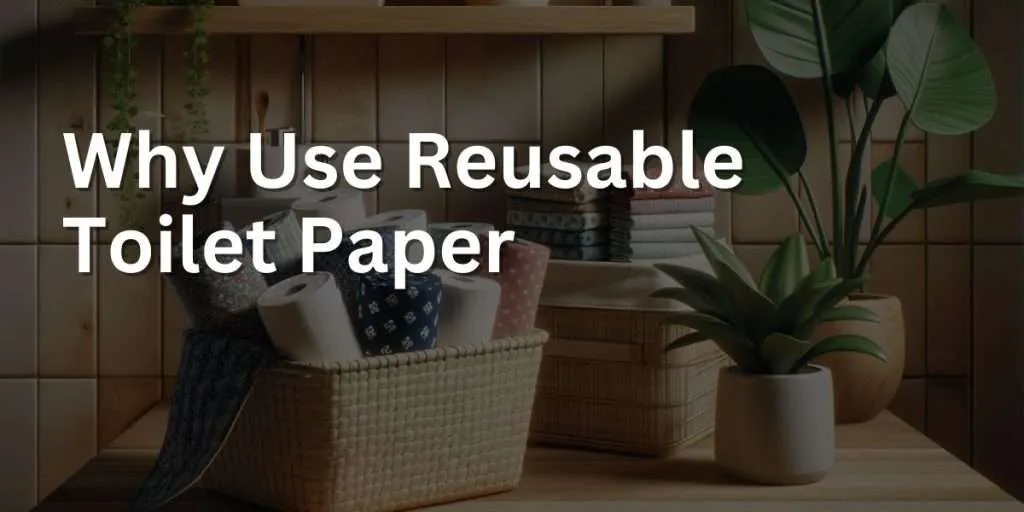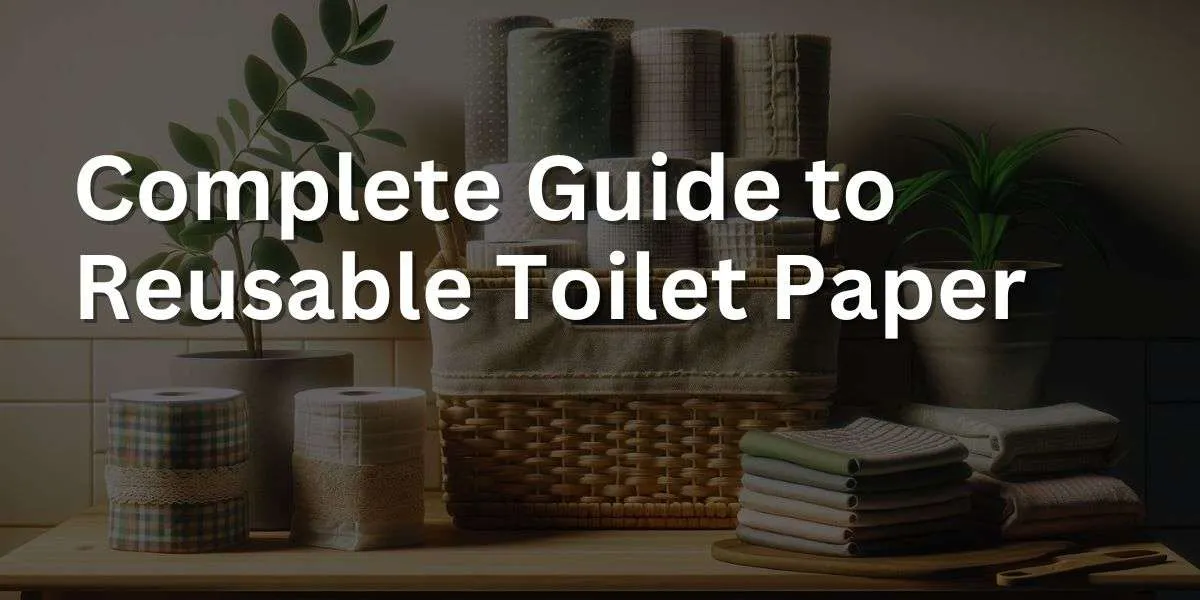The concept of reusable toilet paper may raise eyebrows, but it’s a conversation we need to have in an eco-conscious world.
This article will take a deep dive into the practicalities and hygiene of using cloth wipes for personal care.
From the environmental impact of traditional toilet paper to the best practices for cleanliness and maintenance, we will cover all you need to know about this sustainable alternative.
Get ready to challenge norms and embrace a greener lifestyle—one that’s kind to both the planet and your budget.
Key Takeaways: Reusable Toilet Paper
Eco-friendly alternative. Reusable toilet paper, often made from fabrics like cotton flannel, reduces paper waste and the need for deforestation.
Cost-effective over time. While there’s an upfront cost, reusable options can save money in the long run as they are washable and can last for years.
Hygiene is crucial. It’s important to have a system for washing the cloths thoroughly to maintain hygiene and prevent the spread of bacteria.
Not for everyone. The concept may not be appealing to everyone and can require a significant adjustment in terms of bathroom habits and routines.
Storage and cleaning. Users need to have a sealed container for used cloths and a regular laundering routine, using hot water and a sanitizing method.
User comfort. Some people find cloth to be softer and less irritating than paper, which can be particularly beneficial for those with sensitive skin.
Travel considerations. While reusable options are great at home, they may not be practical for travel or in public restrooms.
Variety of choices. There are many options available for purchase, or they can be homemade, with different patterns and fabric choices to suit personal preferences.
What Is Reusable Toilet Paper?
Reusable toilet paper is cloth that takes the place of regular toilet paper. It’s made from materials like cotton, which can be washed and used again. People choose this eco-friendly option to help the environment by reducing waste. It’s a product that fits well with a lifestyle that cares about sustainability.
When using reusable toilet paper, good hygiene is a must. After use, the cloth is typically placed in a sealed container before it’s washed. Regular cleaning ensures that the reusable toilet paper is safe to use over and over. Washing these cloths doesn’t have to be a hassle. It can be as simple as doing a regular load of laundry, with some extra care to make sure everything is clean.
Is reusable toilet paper safe?
Reusable toilet paper is a safe choice for most people when proper cleaning methods are followed. The cloths are made from fabrics that are gentle on the skin and can be sanitized effectively in hot water. It’s important to handle and store the used cloths correctly before washing to maintain good hygiene.
The process of keeping reusable toilet paper safe involves a few simple steps. After being used, the cloths should be placed in a container with a lid. Then, they are washed in the washing machine at a high temperature with a robust laundry detergent to ensure cleanliness. Drying the cloths at a high temperature or in direct sunlight also helps in disinfecting them.
By taking these steps, users can feel confident in the cleanliness of their reusable toilet paper. This eco-friendly alternative to traditional toilet paper is not just safe; it’s also beneficial for the planet. It cuts down on single-use paper waste and can be part of a positive move towards a more sustainable lifestyle.
Best Reusable Toilet Paper

Why Use Reusable Toilet Paper?
Using reusable toilet paper is good for the environment. It cuts down on the number of trees cut down for paper production. This kind of toilet paper also decreases the amount of paper waste filling up landfills. Every piece of cloth used and washed replaces rolls of paper that would otherwise be thrown away.
Reusable toilet paper is often made from fabrics like cotton or bamboo, which are kind to the skin. People who use these products can save money because they buy less regular toilet paper. A set of family cloth can last for a long time, reducing the need to spend money on disposable products frequently.
Taking care of reusable toilet paper is simple. After using, you just wash them in a washing machine. They come out clean and are ready to be used again. By choosing to use reusable toilet paper, families take a step toward a lifestyle that is more in tune with nature. It’s a practical change with a positive impact on our planet.
Reusable Toilet Paper Has Reduced Environmental Impact
Traditional toilet paper is made from trees, which can take years to grow back. Reusable toilet paper is made from cloth, which can be reused over and over again. By switching to reusable toilet paper, you can help reduce your environmental impact, just like using natural bathroom cleaning products. Each family cloth can be reused hundreds of times.
| Environmental Aspect | Traditional Toilet Paper | Reusable Toilet Paper | Notes |
|---|---|---|---|
| Deforestation | High (15% of deforestation linked to TP production) | None | Millions of trees cut down annually. |
| Water Usage | ~37 gallons per roll | Depends on wash frequency and load size | Washing machine uses about 40 gallons per load; reusable cloths could be less or comparable over time. |
| Energy Consumption | ~1.3 kWh per roll | 0.3 to 1.5 kWh per wash/dry cycle | Energy is spread across many uses of the cloths; efficiency varies by appliance and settings. |
| Chemical Use | Use of bleaching agents and chemicals | Mild detergents, potentially eco-friendly | Chemical runoff from TP production vs. possibly less impactful home laundering. |
| Waste Reduction | ~23.3 pounds of waste per person/year | Significantly less; cloths are reused | Landfill contribution is reduced with reusable cloths. |
| Carbon Emissions | Production and transport contribute to emissions | Emissions from washing/drying | Lifecycle assessment needed; renewables for home laundering can reduce impact. |
Reusable Toilet Paper will give you Cost Savings
Reusable toilet paper can save you money in the long run. A family cloth set costs about £20, which may seem like a lot upfront. However, each family cloth can be reused hundreds of times. Over time, reusable toilet paper will save you money compared to traditional toilet paper. You can even make your own cloth toilet paper with any scrap towels or materials you may have!
| Cost Factor | Disposable Toilet Paper | Reusable Toilet Paper | Notes |
|---|---|---|---|
| Initial Investment | None | Moderate (purchase of cloths) | Cost of buying reusable cloths can vary based on material and quantity. |
| Average Cost Per Use | Varies (dependent on brand and quality) | Decreases over time | Reusable cloth costs spread over many uses; disposables are a constant expense. |
| Longevity | One-time use | Years, depending on care | Reusable cloths can last for years, while toilet paper is designed for single use only. |
| Maintenance Costs | None | Water, electricity, detergent | The cost of washing and drying reusable cloths must be considered. |
| Replacement Frequency | High (weekly/monthly purchases) | Low (occasional cloth replacement) | Disposable rolls need regular replacement; cloths may only need occasional replenishing. |
| Annual Cost Estimate | Varies widely | Depends on maintenance costs | Calculations would be needed based on local utility costs and washing frequency. |
| Break-Even Point | N/A | Varies | The point at which initial investment in cloths is offset by savings on disposables. |
Reusable Toilet Paper Can Give Improved Hygiene
Yes, we do mean improved hygiene. You can make cloth wipes to any size you want, so you can ensure if you make them large enough there is no need to worry about any missed spots. You can also add essential oils to your homemade wipes for an extra cleansing boost.
They also give a much better clean! If you have every changed cloth diapers or nappies, you will know how you get a much better cleanwith a wet cloth compared to a dry cloth. If you use your own reusable toilet paper, you can opt to use these dry or wet (or just
- Pre-Washing Storage: Store soiled cloths in a dedicated, sealed container. Consider a pre-treatment with a vinegar solution to aid in disinfection.
- Wash Cycle Temperature: Use hot water for the wash cycle to sanitize the cloths effectively.
- Natural Disinfectants: Add natural disinfectants like vinegar or antibacterial essential oils, such as tea tree oil, to your wash to enhance sanitation.
- Thorough Drying: Dry the cloths completely, using a high-heat setting in your dryer or by placing them in direct sunlight, which can help eliminate pathogens.
- Laundry Separation: Always wash your reusable toilet paper separately from other household laundry to prevent any cross-contamination.
- Illness Protocol: If someone in your home is sick, consider using separate bins for their cloths and increase the disinfection measures in your wash.
- Cloth Inspection and Replacement: Routinely inspect your cloths for wear and tear, and replace them as necessary to maintain a high hygiene standard.
- Handwashing: Always wash your hands thoroughly after handling used cloths and after using the restroom, to protect yourself and prevent the spread of germs.
Reusable Toilet Paper Produces Less Waste
By switching to reusable toilet paper, you will produce less waste overall. Traditional toilet paper comes in packaging and each roll is only meant to be used once. On the other hand, family cloths can be used over and over again, which reduces the amount of waste you produce.
Traditional toilet paper creates a lot of waste. Each roll of toilet paper contains about 200 sheets of paper. That means that each person uses about 100 rolls of toilet paper per year! That’s a lot of paper that ends up in the landfill. Reusable toilet paper eliminates this waste, as you can simply wash and reuse the cloth over and over again.
Reusable Toilet Paper Will Give you More Comfort
Reusable toilet paper is often softer and more comfortable than traditional toilet paper. Traditional toilet paper is usually made from recycled paper, which can be harsh on your skin. Reusable toilet paper is made from cloth, which is much softer and gentle on your skin.
Reusable Toilet Paper Is Healthier for you
Traditional toilet paper is usually made from paper which can be bleached and have parfum added, which can contain harmful chemicals. Many people are often allergic to these additives added to traditional toilet paper. Reusable toilet paper is made from natural materials like cotton, which is much healthier for you and gentle on your skin.
Reusable Toilet Paper Is Eco-friendly
Reusable toilet paper is made from cloth, which can be reused over and over again. By switching to reusable toilet paper, you can help reduce your environmental impact.
Reusable Toilet Paper Is Convenient
Reusable toilet paper is just as convenient as traditional toilet paper. You can keep a stash of cloths in your bathroom, and simply wash them after each use. Most people will store used ones in a wet bag until you are ready to wash.
Reusable Toilet Paper Can Be Stylish
Reusable toilet paper comes in a variety of colors and patterns. You can find cloths that match your bathroom’s décor, or go for a more funky look.
Sustainable Choices: Reusable Toilet Paper vs. Other Eco-Friendly Alternatives
When it comes to eco-friendly bathroom habits, reusable toilet paper is just one of several sustainable options available. Understanding how it stacks up against other alternatives can help you make the best choice for your lifestyle and values. Here’s how reusable toilet paper compares to other green options like bamboo toilet paper and bidets:
- Bamboo Toilet Paper
- Sustainability: Bamboo grows rapidly and requires less water than trees, making bamboo toilet paper a more sustainable choice than traditional tree-based products.
- Biodegradability: Unlike cloth, bamboo toilet paper is biodegradable and can be a better option for those without access to efficient laundering facilities.
- Cost: While bamboo toilet paper may be more expensive than traditional toilet paper, it generally is less expensive than investing in reusable cloths, which also incur laundering costs.
- Bidets
- Water Usage: Bidets use water for cleaning, which can be more eco-friendly than paper or cloths, especially if the bidet is equipped with efficient water-saving features.
- Hygiene: Many people find bidets to be more hygienic than toilet paper, as they provide a gentle and thorough cleaning without the need for physical wiping.
- Installation Cost: The initial cost of installing a bidet can be high, but over time, it can lead to savings on purchasing paper products.
The Verdict:
- For the Budget-Conscious: Bamboo toilet paper might be a good middle-ground, offering a balance of sustainability and convenience without the need for laundering.
- For the Eco-Purist: Reusable toilet paper is a strong contender if you have a reliable laundering routine and are committed to minimizing waste.
- For Those Seeking Comfort and Hygiene: A bidet could be the best investment, especially for those willing to pay more upfront for long-term savings and a more luxurious bathroom experience.
How to Wash Family Cloth (Reusable Toilet Paper)
Use a dedicated bin. Store used cloths in a bin with a lid or a wet bag to contain odors and moisture until you’re ready to wash them.
Pre-rinse if necessary. You may choose to rinse or soak the cloths in cold water before washing to help remove stains and debris.
Hot water wash. Wash the cloths on a hot cycle with a full dose of detergent to ensure thorough cleaning and sanitization.
Consider a double wash. For added cleanliness, you can run a second wash cycle.
Dry thoroughly. Dry the cloths completely in a dryer on high heat or hang them in the sun for natural bleaching and disinfecting.
Avoid fabric softeners. Skip fabric softeners and dryer sheets as they can reduce absorbency over time.
Use bleach sparingly. While bleach can be used occasionally for sanitizing, it can break down fibers more quickly, so use it sparingly or opt for alternative disinfectants.
Handle with care. If dealing with illness, wear gloves when handling soiled cloths and consider adding a disinfectant to the wash cycle.

How can you make your own family cloth
Making your own family cloth is a straightforward process. You start with selecting the right fabric, which should be soft and absorbent, like flannel or cotton. Once you have your fabric, cut it into squares of a convenient size, usually the same size as regular toilet paper.
After cutting the fabric to size, the edges of the squares need to be hemmed to prevent fraying. You can do this with a sewing machine or by hand-stitching. If you have a serger, it’s even better for securing the edges. Once the edges are finished, your family cloth is ready to use.
Caring for your homemade family cloth is easy. Keep used cloths in a sealed container until you’re ready to wash them. Wash them in hot water with a good detergent, and dry thoroughly. With proper care, these cloths can be used again and again, offering a sustainable alternative to traditional toilet paper. It’s a simple way to reduce waste and care for the environment.







